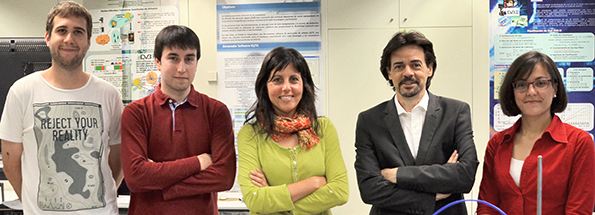Phantoms
The UPV develops new synthetic models for creating technology medical examination and testing of devices 5G
[ 13/07/2016 ]
Researchers at the Universitat Politčcnica de Valčncia (UPV) have developed new synthetic models (phantoms) that simulate the electromagnetic properties of several human tissues and organs, such as complex relative permittivity, dielectric constant, loss factor and conductivity. These models may be of interest for developing new technologies for medical screening, and in general, for testing 5G mobile communication devices. The researchers also devised the methodology to create the phantoms.
Recently, there has been a growing interest in the use of new telecommunication devices that facilitate clinical diagnosis when implanted in the organism. These units can be integrated inside capsules and taken orally. This is the case for sensors and medical monitoring systems that register biological information inside the body and later transmit it outside.
Electromagnetic waves through the body
According to UPV researchers, these devices wirelessly communicate sending electromagnetic waves through the body, which acts as a transmission medium. In order to develop and test them before they are marketed, it is necessary to perform tests on animals and humans.
In fact, the models and methodology developed by the researchers and patented by the Universitat Politčcnica de Valčncia will reduce testing on animals and humans. They will help to assess the transmission of electromagnetic waves in UWB (ultra-wide band) frequency, which is between 3.1 and 10.6 GHz; and will take part on future personal area networks, as well as other networks of narrower bands, such as ISM networks.
The phantom is a liquid mixture or a crosslinked polymer (hydrogel) that can be formed according to the shape and size of interest, in order to simulate a specific organ at an electromagnetic level that is able to hold those liquids or mixtures.
Simulating "on demand"
With the new methodology developed by the researchers, organs such as the liver, heart, pancreas, colon and cartilage can be simulated “on demand” from an electromagnetic point of view. For some of them, there are no phantoms on the market today, nor proposals for any in the future, not even for a specific frequency.
Noticias destacadas
 ˇHola!
ˇHola!
El curso 2024-2025 arranca en la Universitat Politčcnica de Valčncia con un mensaje: aquí, tú eres la estrella
 ERC Advanced Grant
ERC Advanced Grant
El Consejo Europeo de Investigación financia un proyecto del ITQ, liderado por Hermenegildo García, para avanzar en la descarbonización
 Referenciará el precio por m2
Referenciará el precio por m2
La Cátedra Observatorio de la Vivienda UPV, clave en el nuevo Decreto de Vivienda de Protección Pública presentado por la Generalitat Valenciana
 Un estudiante de la UPV, premiado
Un estudiante de la UPV, premiado
Abdullah Al-Droubia cursa actualmente el programa de doctorado en Administración y Dirección de Empresas de la Universitat Politčcnica de Valčncia
 Pedaleando con Dones de Cičncia
Pedaleando con Dones de Cičncia
La UPV y el Ayuntamiento de Valčncia arrancan la tercera edición de las rutas guiadas en bicicleta por murales de Dones de Cičncia






